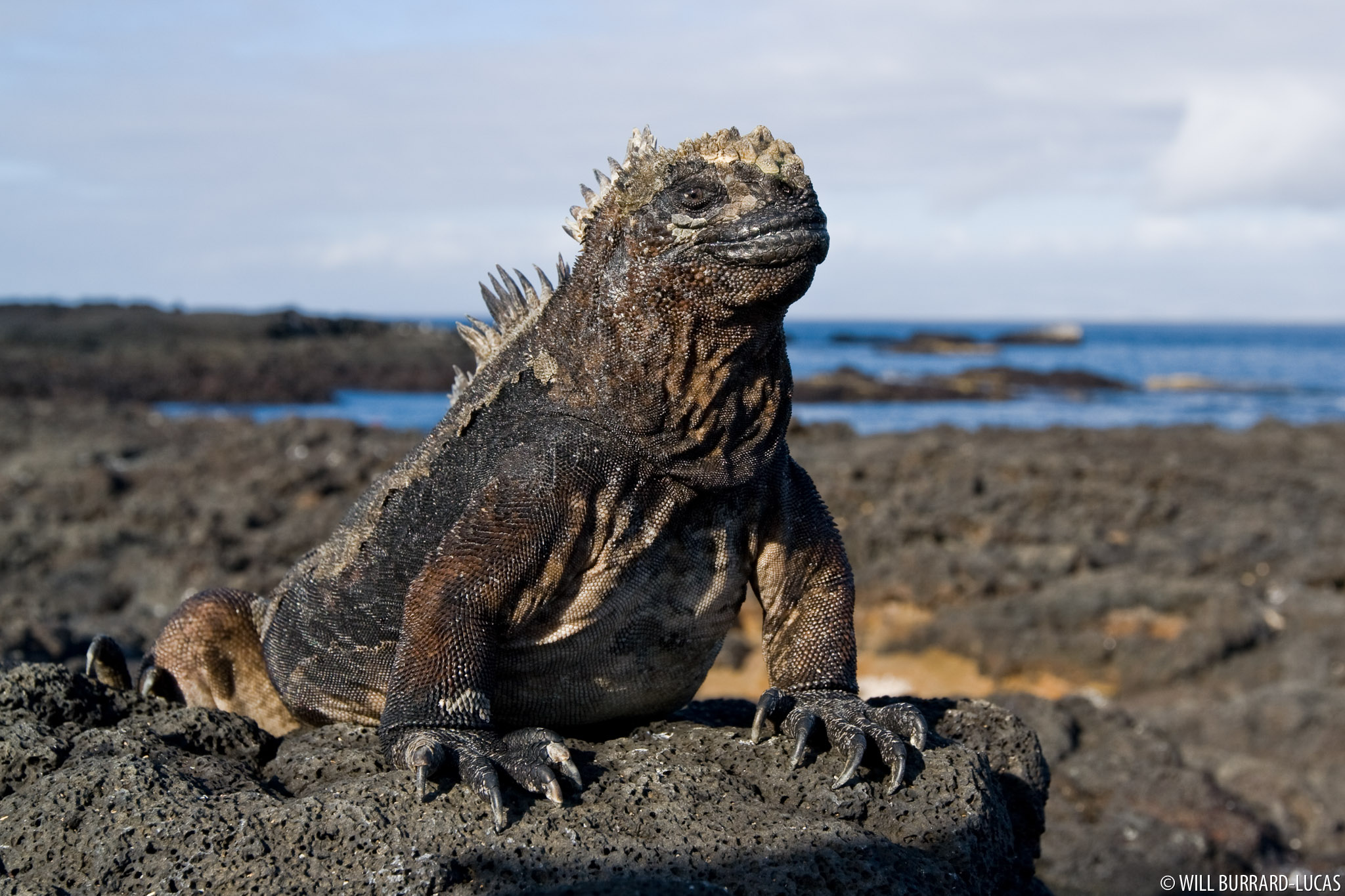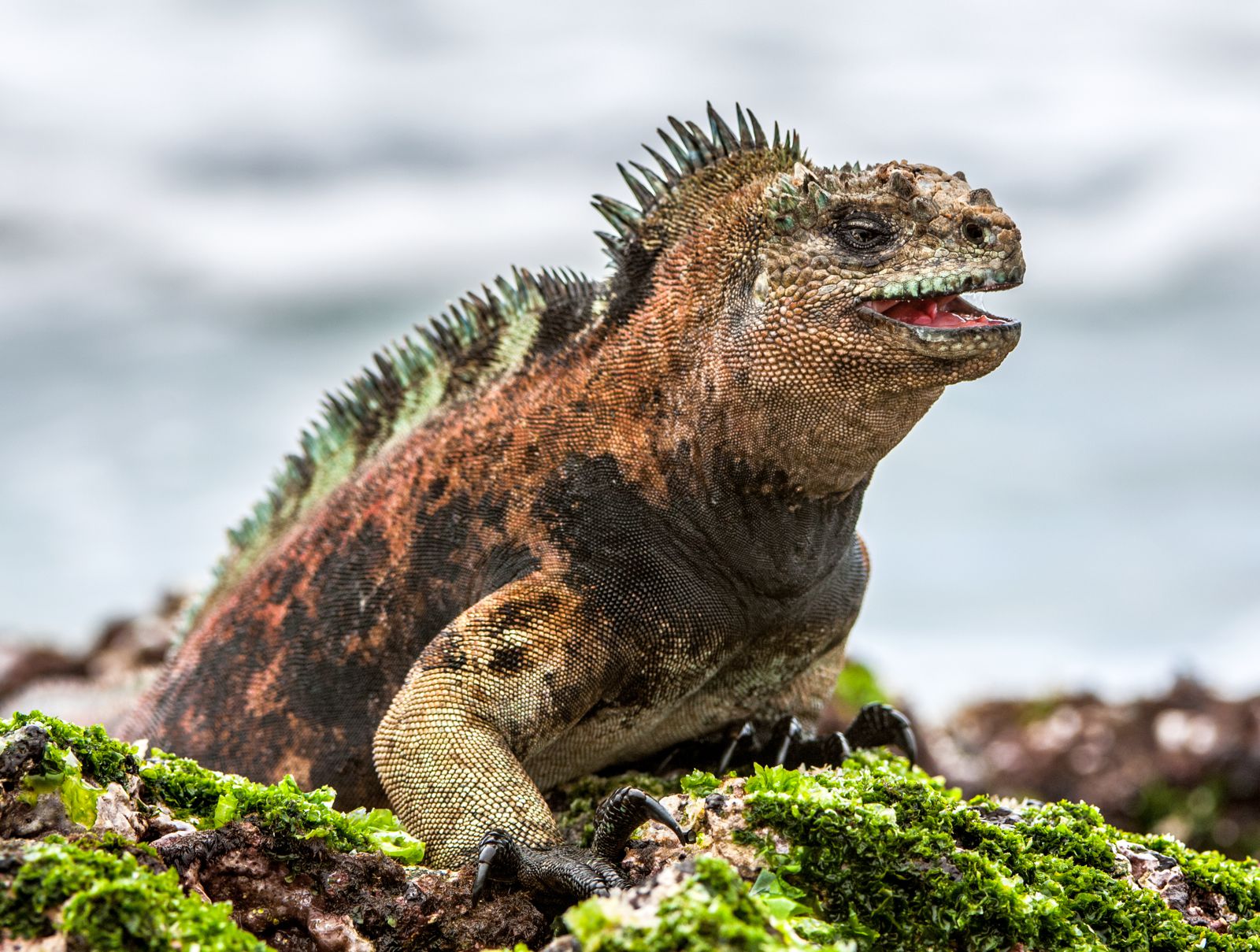
How to Visit The Galapagos Islands Without a Cruise A Complete Guide
Travel Digital Nomad Galápagos Iguanas By Andrew Evans Published February 15, 2013 • 2 min read When Darwin camped in Galápagos back in 1835, the young British traveler found it difficult to.

Galapagos Iguana Will BurrardLucas
Marine iguanas are vulnerable, but since the creation of the Galapagos Marine Reserve in 1998, their status has somewhat improved. Their primary predators are birds, such as hawks, owls and herons when they are young, and the Galapagos hawk when they are adults. And they are also threatened by introduced cats, rats, dogs and pigs.

Galapagos land iguana (Conolophus subcristatus) Natural Creations
The Galapagos land iguana is one of three species of land iguana endemic to the Galapagos Islands (the others being the Santa Fe land iguana and the Galapagos pink land iguana ). Their skin is generally yellow with white, black and brown blotches.

Marine Iguana of the Galapagos Islands Andean Discovery
The marine iguana is the only lizard in the world with the ability to live and forage at sea, and is endemic to the Galapagos Archipelago. There are eleven very similar subspecies, found on different islands, with those from Isabela and Fernandina being the largest.

Wild (life) Travel Adventures Part 2 ExpertFlyer Blog
Marine Iguanas are found throughout the Galapagos Islands, but nowhere else in the world, which makes them yet another endemic creature of the Galapagos Isles. The largest populations and the largest individuals, are found in the western islands of the archipelago.

The Unique Marine Iguanas Of The Galápagos Islands
Currently, there are four species of iguanas in the Archipelago: the Marine Iguana ( Amblyrhynchus cristatus ), found on Isabela, Santa Cruz, San Cristóbal, and Fernandina Islands as well as other islets around them; the Pale Land Iguana ( Conolophus pallidus ), restricted to Santa Fe Island; the Yellow Land Iguana ( Conolophus subcristatus) dis.

Marine Iguana, Galapagos by Morten Ross Marine iguana, Iguana, Galapagos
The Pale Land Iguana is restricted to Santa Fe Island. The Yellow Land Iguana can be found on Fernandina and Isabela Islands. The Pink Iguana was discovered in a rare species that lives on Isabela Island's Wolf Volcano. Galapagos Iguanas are more than a tourist attraction. Their uniqueness has made them the center of scientific attention.

Galapagos Wildlife Calendar Discover Your South America Blog
Galapagos land iguana. The mating season of Galápagos land iguanas varies between islands. Soon after mating, the females migrate to sandy areas to nest and they may travel up to 15 km (9 miles) to find good nesting sites. They lay 2-20 eggs in a burrow about 50 cm (20 in) deep. The eggs hatch anywhere from 90 to 125 days later.

Marine Iguana, Galapagos, Ecuador, Lizard, Animals, Animales, Animaux
The Galápagos land iguana ( Conolophus subcristatus) is a very large, species of lizard in the family Iguanidae. It is one of three species of the genus Conolophus. It is endemic to the Galápagos Islands, in the dry lowlands of the islands of Fernandina, Isabela, Santa Cruz, North Seymour, Baltra, and South Plaza. [1] [3] [4] Taxonomy
:max_bytes(150000):strip_icc()/__opt__aboutcom__coeus__resources__content_migration__mnn__images__2016__03__sunbathinggalapagosiguana-9e32074f433743bcb49302974b0075b8.jpg)
9 Illuminating Facts About Iguanas
Yellow iguanas are much-loved denizens of the dry lowlands of Galápagos. Once widespread across much of the archipelago, they are now limited to just a few areas and among them are three islands — Baltra, North Seymour, and Santiago — whose past and future fates are intimately intertwined in ways few people know. Here's the story

Shocking photos of Galapagos iguanas struggling to survive climate
The Galapagos land iguanas are found in the dry lowlands of the islands of Fernandina, Isabela, Santa Cruz, North Seymour, Baltra, and South Plaza. These islands are part of the Galapagos Province of the Republic Of Ecuador. These iguanas prefer habitats that offer ample sun for basking, such as volcanic rocks.

GALAPAGOS ISLANDS 2019 Just 1 Spot Open!March 30 April 6
Found only on the Galápagos Islands, marine iguanas often wear distinctive white "wigs" of salt expelled from glands near their noses. Photograph by Tim Laman, Nat Geo Image Collection.

Galápagos Marine Iguana International Iguana Foundation
Marine iguanas are endemic to the Galapagos Islands and are the only marine lizard species in the world. 2. Marine iguanas can dive more than 65 feet (20 m) underwater. 1. 3. Unlike land lizards, marine iguanas have blunt snouts that help them feed on algae underwater. They also have flattened tails that help them swim efficiently.

Animals Wallpapers galapagos land iguana
Key points: Iguanas populated the island in vast numbers when Charles Darwin visited in the 1830s Scientists believe the iguana disappeared from the island in the early 20th century The boom is a result of reintroduction efforts three years ago

landiguanagalapagosislandsecuador
One reason is that for years the iguanas were presumed, unlike Darwin's famous Galápagos finches, to be fairly uniform across the islands, making the stakes for the animal lower even if one.

11 Unique Animals You Have To See In The Galapagos Islands, Ecuador
Land iguanas can be spotted in the Galapagos Islands all year around. Land Iguana Behavior Land iguanas live for approximately 50 years in total. They are mostly herbivores. However, all three species will act in a carnivorous way if an opportunity presents itself. They will eat insects and carrion at times.